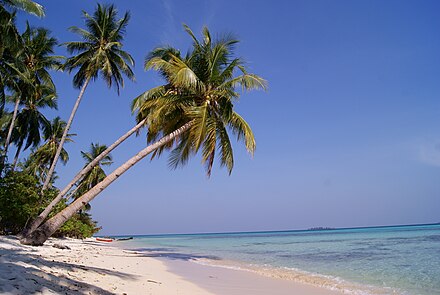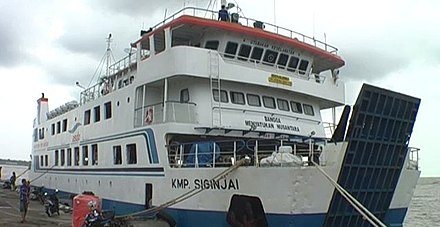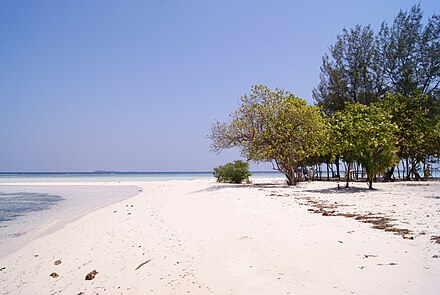Karimunjawa - island group in Central Java, Indonesia
Karimunjawa is a chain of 27 islands north of Semarang, off the coast of Central Java, Indonesia, that has been designated as a national marine park.
Understand
Karimunjawa consists of 27 small islands, the main ones being Karimunjawa, Kemujan, Menjangan Besar and Menjangan Kecil.
Since June 2016, there is 24-hour electricity in most places on Karimunjawa Island, though some other islands may receive as few as six hours per day.
Orientation
Most facilities for travelers are found on the largest island, also called Karimunjawa. The main settlement is at the southern end of that island. It is where ferries dock and most services are to be found. Accommodation is scattered across the island.
Travel out to the furthest islands in the archipelago will take two or more hours depending on the type of boat used.
Climate
Tropical. It is very hot here in the dry season (approximately April to October) and wet and humid in the rainy season (December till March).
History
According to a local legend, Karimun means not clear or obvious, because in clear weather the islands can be seen from the coast of mainland Java, but not clearly.
Karimunjawa was first settled by Sunan Nyamplungan, the son of Sunan Muria, one of the Muslim Saints (Sunan) who introduced Islam to Java.
Karimunjawa is more famous than Bali (who was only a base for pirates for long) since centuries. The island has been known by navigators worldwide as a haven on the trade roads trough java sea to Borneo or Spices Islands and can be found under different names (Tortuga, Chirimao, Carimon jawa...) on all antique portulans and maps of the area.
Historical sources relate the discovery of the Archipelago by Chinese Army sent by emperor Kubhilai Khan in 1293 (they named it CHI-LI-MEN), followed by Ottoman Turkish navigators in 1403, Portuguese, Dutch, French (Bouguinville), and English. Archeological researches have found porcelains from the Ming dynasty.
Many Yachtmen stop now in Karimunjawa on their way from Australia to Thailand or the China sea or back.
Landscape

Flora and fauna
One can find various kinds of sea animals, like turtles, sharks, and fishes, in the watery territory of Karimunjawa. On land, there are birds, deer, monkeys and snakes. Entrance to the natural forest requires a National Park guide.
Talk
Javanese is the most common language of communication between local residents, with Indonesian widely used and understood as the national language. English is not widely understood, so knowledge of some Indonesian is recommended.
Get in
By boat
 There are regular ferries from Jepara, Semarang and Kendal, except during the monsoon season from December to February when the waves may be too high for a day or two. There was a severe case on December 31, 2014 when about 500 tourists could not go back to Java due to 3.5-m-high waves and the ATMs ran out of money after 3 days, because some of the coal cargos also landed to avoid high waves and its crew also used the ATMs. Cash for at least 5 days should be prepared, because vendors still have their merchandise.
There are regular ferries from Jepara, Semarang and Kendal, except during the monsoon season from December to February when the waves may be too high for a day or two. There was a severe case on December 31, 2014 when about 500 tourists could not go back to Java due to 3.5-m-high waves and the ATMs ran out of money after 3 days, because some of the coal cargos also landed to avoid high waves and its crew also used the ATMs. Cash for at least 5 days should be prepared, because vendors still have their merchandise.
From Jepara
- There is a regular ferry, travelling 5 hours from Jepara (Rp60,000) to Karimunjawa Island. Be at the port before 06:00, as the ferry sometimes departs earlier than scheduled. The ferry departs at 07:00, four times a week.
- There is also a speedboat, travelling 2 hours from Jepara to Karimunjava (Express Bahari, Rp150,000). It departs at 09:00, four times a week. In high season it may need to be booked in advance. Go to the office along the street to Jepara port or ask your hotel to do it for you.
All boats are only operational if the waves are none to medium.
From Semarang
The state-owned, PELNI provides two ships to go to Karimunjawa, KM. Lawit and KM. Kelimutu. The cheapest fare is Rp90,000. You may check the schedule in the PELNI office Semarang Branch or by PELNI app.
There is also a fast boat, KMC. Kartini from Tanjung Emas Port.
From Kendal
- Express Bahari, +62 822 4180-0700 (Kendal), +62 297 312333 (Karimunjawa). Departing Kendal for Karimunjawa at 08:30 on Tuesdays and Fridays. Departing Karimunjawa for Kendal at 12:00 on Wednesdays and Sundays. Kendal is the town immediately to the west of Semarang, reachable by bus and train. The crossing is scheduled to take two and a half hours; traveler feedback indicates three to four hours is more realistic. Schedules are not reliable and services may be cancelled at the last minute if there are not enough ticket sales. VIP tickets Rp260,000 2017-10-30
By plane
- Dewandaru Airport (IATA: KWB), -5.8015°, 110.4788°. There are flights with Airfast from Surabaya. Travel from the airport to town takes about 45 minutes.
- Airfast, +62 812 3777-9610 (Surabaya ), +62 812 3777-9614 (Karimunjawa). Departing Surabaya for Karimunjawa at 11:31 on Tuesdays and 11:40 on Thursdays, arriving 1 hr 20 min later; departing Karimunjawa for Surabaya at 08:00 on Wednesdays and 13:45 on Thursdays. Tickets may be ordered over the phone but must be paid for and collected in person at the airport of departure. The system seems to be the one who pays first gets the ticket, so even if you order a ticket over the phone, it is not yours until you pay for it. Cost for a taxi from the airport to the Karimunjawa town is around Rp350,000. Rp379,900 single for flights from Surabaya to Karimunjawa; Rp309,900 single for flights from Karimunjawa to Surabaya 2017-10-30
- There are direct flights from Jakarta to Karimunjawa and flights via Semarang. The second option is considered to be cheaper.
Get around
On Karimunjawa and Kemujan islands you can rent cars or motorcycles. Boats are available to get to the other islands. It might be a good idea to book a rental car before you arrive in Karimunjawa because there are few cars.
See

 Beaches and beautiful coral reefs.
Beaches and beautiful coral reefs.
Beaches
- Alano Beach (Pantai Alano), -5.841312°, 110.473438°. 2022-08-27
- Batu Putih Beach (Pantai Batu Putih), -5.804937°, 110.488062°. 2022-08-27
- Batu Topeng Beach (Pantai Batu Topeng), -5.838313°, 110.415063°. 2022-08-27
- Bobby Beach (Pantai Bobby), -5.869938°, 110.448688°. 2022-08-27
- Cemara Besar Island (Pulau Cemara Besar), -5.806188°, 110.374437°. 2022-08-27
- Menjangan Kecil Island (Pulau Menjangan Kecil), -5.890437°, 110.409312°. 2022-08-27
- Seruni Island (Pulau Seruni), -5.862563°, 110.583062°. 2022-08-27
- Sintok Island (Pulau Sintok), -5.784813°, 110.511687°. 2022-08-27
- Ujung Gantungan Beach (Pantai Ujung Gantungan), -5.888312°, 110.422938°. 2022-08-27
- Ujung Gelam Beach (Pantai Ujung Gelam), -5.839688°, 110.411062°. 2022-08-27
Wildlife
- Konservasi Penyu Taman Nasional Karimunjawa, -5.865813°, 110.454687°. Sea turtle conservation. 2022-08-27
- Penangkaran Hiu Karimunjawa, -5.882188°, 110.427437°. Blacktip and whitetip reef sharks conservation. 2022-08-27
Do
 Diving and snorkelling. There are many interesting spots for diving like Taka Panyawangan and Gosong Cemara. There are some shipwrecks that attract fish and divers alike.
Diving and snorkelling. There are many interesting spots for diving like Taka Panyawangan and Gosong Cemara. There are some shipwrecks that attract fish and divers alike.
- Cilik Island (Pulau Cilik), -5.820063°, 110.508313°. Find a nemo. 2022-08-27
- Gelean Island (Pulau Gelean), -5.879938°, 110.353562°. Find a nemo. 2022-08-27
- Kemujan Island (Pulau Kemujan), -5.799938°, 110.466688°. Shipwreck diving. The cooperation coal ship between Indonesia and Norway sank in the water of Kemujan in 1960. 2022-08-27
You can also go hiking around the island to find many places where there is a beautiful panorama.
- Love Hill (Bukit Love), -5.862312°, 110.435438°. 2022-08-27
There is also mangrove trekking.
- Mangrove Area Tourism (Kawasan Wisata Mangrove), -5.827687°, 110.467687°. 2022-08-27
Buy
The best known handicrafts in Karimunjawa are its wood carvings, and many shops sell them.
Many people also go to Karimunjawa to find the dewandaru plant, believing it can prolong life.
Eat
Karimunjawa cuisine
- Bakso ikan ekor kuning, a fish ball soup.
- Lontong krubyuk, a rice cake with chicken, cabbage, tofu, and bean sprout in a brown soup.
- Tongseng cumi, squid in a sweet and spicy gravy.
Food stalls
Surrounded by sea, Karimunjawa offers lots of seafood. Fresh fish and prawns are staples in the island diet. Restaurants are located within hotels. Other eateries, or warungs, provide decent cheap food like fried rice, fish, or an assortment of veggies. Be flexible and you'll do fine.
- Alun-alun Karimunjawa, Karimunjawa, -5.880187°, 110.432688°. In the alun-alun (town public park), there are a lot of seafood stalls. They serve grilled fish and the local dish tongseng cumi. 2022-08-27
- Bakso Ikan Ekor Kuning Bu Daton, Karimunjawa, -5.878563°, 110.432812°. Serves bakso ikan ekor kuning. 2022-08-27
- Eat & Meet, Jl H Dr Soetomo RT01 RW02, Karimunjawa (near the ATM), -5.879162°, 110.434922°, +62 297 319-1103. Wood-fired pizza, pasta, beer, ice cream. 2022-08-27
- Warung Makan Sami Roso, Jl. Dr. Sutomo, Karimunjawa, -5.879563°, 110.434188°. Serves lontong krubyuk. 2022-08-27
Drink
There are no clubs and only one lounge bar, the Cumibar. It is difficult to find alcohol, but it can be found at Breve Azurine (Cumibar & Lumba Beach Snack Bar), the Eat & Meet restaurant and The Happinezz hostel. A beer costs about Rp45,000.
Bottled water can be bought readily. At meals, seasonal fresh fruit juice is a treat (mango, orange, avocado). The whole coconut drink is very common with a reasonable price of Rp10,000-20,000.
Sleep
There are various kinds of accommodation, from four star hotels to homestays and campsites.
Hotel
- The Happinezz Hills, Jl. I. J. Kasimo (on a hill near viewpoint Bukit Love), -5.8755°, 110.4338°, +62 877-3779-3332, Info@thehappinezzhills.com. Check-in: 14:00, check-out: 12:00. Offers 12 double rooms, 4 twin rooms, and 1 family bungalow. Every room has been decorated in one of these four themes: beach, ocean, nature or sunset, based on the beautiful surroundings. The swimming pool includes a pool bar. A daily Western and Asian breakfast is served in the onsite restaurant. Scooters for rent.
Homestay
- Mulya Indah Homestay, Jl. Pemuda, -5.878937°, 110.433797°, +62 812 260 06329. From Rp80,000 2022-08-27
- Arriani Homestay, Jl. Pangeran Diponegoro (near the main mosque), -5.878937°, 110.433797°, +62 818 086 56588. Check-in: 12:00, check-out: 12:00. From Rp100,000 2022-08-27
Lodging
- Roemah Emak Villa, -5.882118°, 110.439666°. A relaxing home for family, next to the beach. 2018-01-27
Mid-range
-
Blue Laguna Inn, -5.881438°, 110.437687°. 2022-08-27
-
Dewadaru Resort, -5.883062°, 110.441063°. 2022-08-27
-
Wisma Apung Karimunjawa, -5.879938°, 110.426563°. A hotel in the middle of the sea. 2022-08-27
-
Escape Beach hotel, -5.884187°, 110.442937°. 2022-08-27
-
Halo Sustainable Resort, Jl. Kemojan, -5.870688°, 110.433813°, +62 812 222 33979. Check-in: 14:00, check-out: 12:00. From Rp668,801 2022-12-06
Splurge
- Kura-kura Resort, -5.7984°, 110.3437°, +62 24 7663-2510, info@kurakuraresort.com. On Menyawakan Island. Shaded by coconut trees and surrounded by white sand beaches and pristine coral reefs. A high class hotel with scuba facilities. 2018-01-27
- Breve Azurine Lagoon Resort (Jiwaquest), -5.8816°, 110.44756°, +62 297 319-1059, breveazurine@gmail.com. Five minutes to the east of Karimunjawa town, on Lele lagoon. Twelve rooms, 2 restaurants and bars. 2018-01-27
Stay safe
For beginner snorkelers, it is recommended to wear a life jacket.
Go next
In practice, the only option is to go back to the mainland of Java: either by ferry to Jepara, Kendal or Semarang, or by plane to Surabaya.
Karimunjawa
karimunjawa.jepara.go.idagenwisatakarimunjawa.comkarimunjawa.co.idDate Time:Please wait...Timezone:Asia/JakartaCoordinates:-5.82, 110.46
Kabupaten Jepara
2nd-order administrative division
Central Java
Primary administrative division